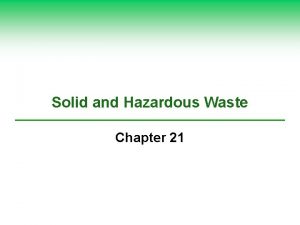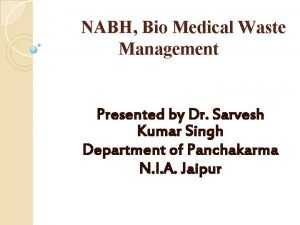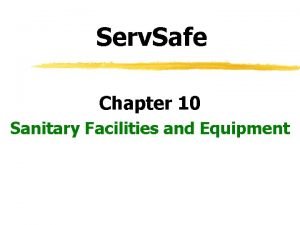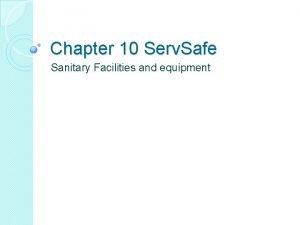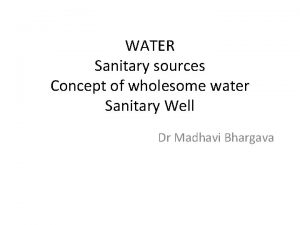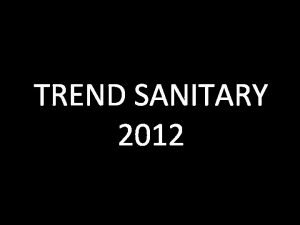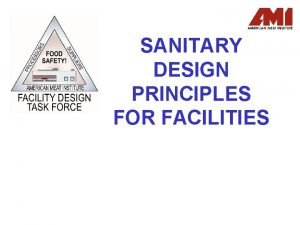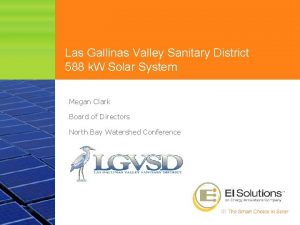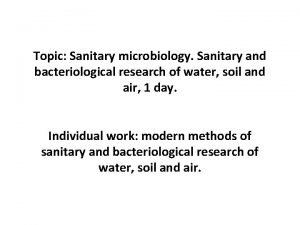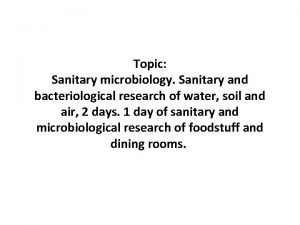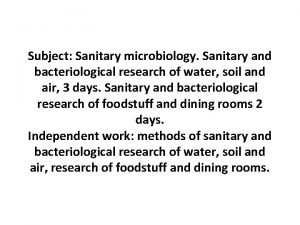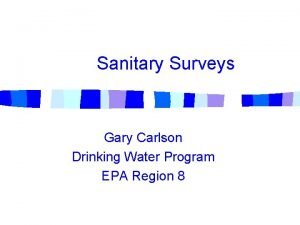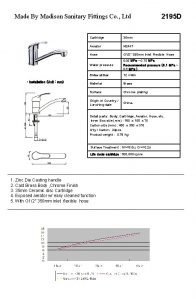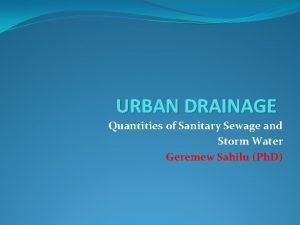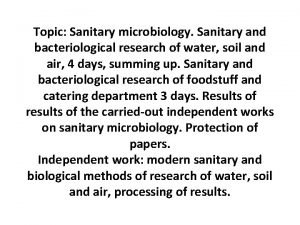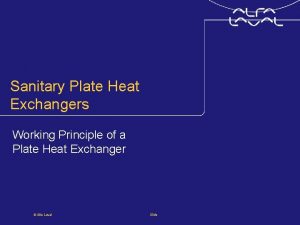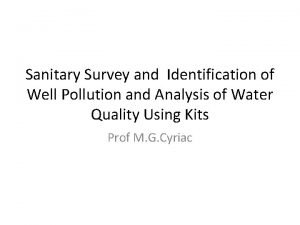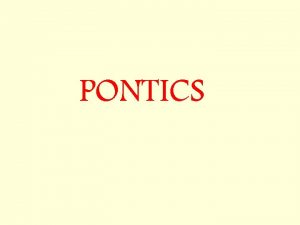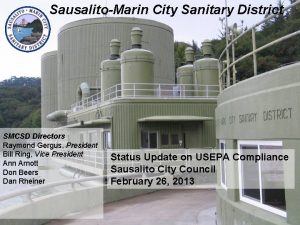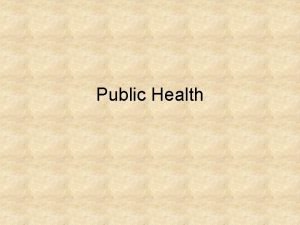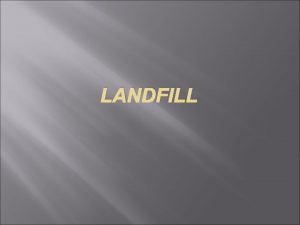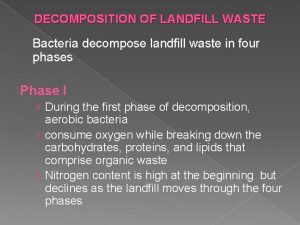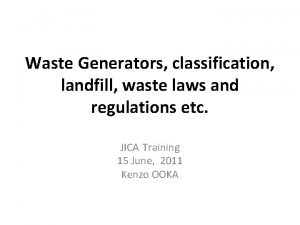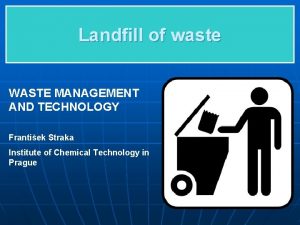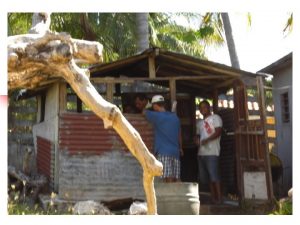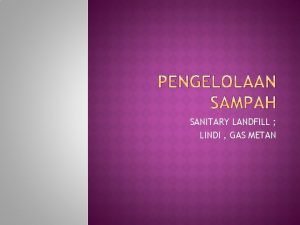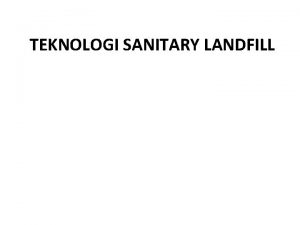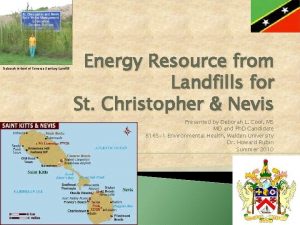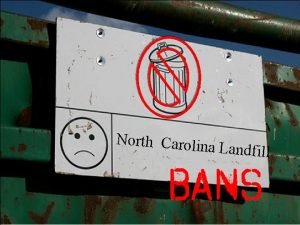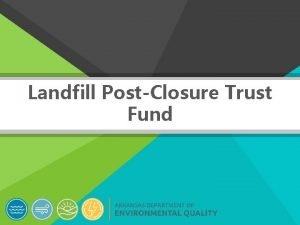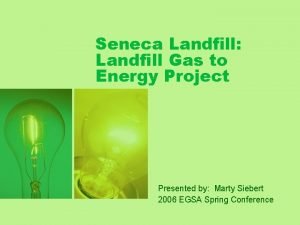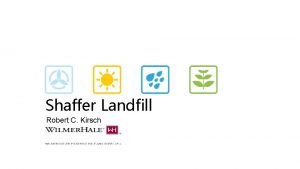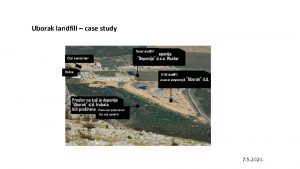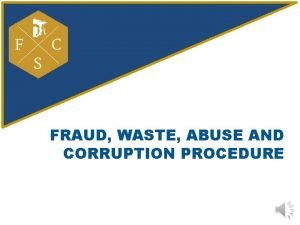Waste Landfill Procedure and Sanitary Landfill 16 June


























- Slides: 26

Waste Landfill Procedure and Sanitary Landfill 16 June 2011 JICA Training Kenzo OOKA

History of landfill • Jomon era (period: BC 10, 000 ~ BC 400) • A shell mound BC 3500, one of the oldest landfill (kitchen midden)

About 7 km from the seaside 2021/3/12 3

2021/3/12 4


2021/3/12 6

2021/3/12 7

1950 s • Up until 1950 s, they merely dumped waste without any cover soil or leachate treatment • Some are utilized for land reclamation – Offensive odour and smoke by field burning, fly infestation, and water pollution etc. • The public cleansing law was enacted in 1954 – Promoted waste incineration rather than dumping – Rapid economic growth & large volume of waste – Minamata, Itai-itai, Yokkaiichi asthma etc.

Open Dumps and Sanitary Landfills • Open dumping – Piled as high as equipment allows – Without regard to safety, pollution, health risks – Refuse is ignited, burnt (reduction? ) & compacted – Aesthetic problems, maybe natural degradation • Sanitary landfills – Confine the waste to the smallest practical area – Cover it with a layer of compacted soil everyday – Minimizing the amount of surface water entering into and gas escaping from the wastes

Sanitary Landfills • Potential hazards – Groundwater and surface-water pollution – The cap soil is more than 50 cm thick (compacted) – Percolating water- waste- leachate – lateral move – Escape of methane gas (can migrate hundreds meters) • Plastic liner and clay • Leachate and gas collection systems

The feasibility of landfill (Floodplains or swampy area, dry clay pits? ) • Site selection – Geology and hydrology, topographic relief etc. – Groundwater table and hydraulic conductivity (leachate moves quickly through the sand/gravel) – Precipitation and river flow networks • Design factors – Multiple barrier – Leachate/gas collection systems – Compacted clay cap and monitoring wells

Technical standard for landfills • Sign board and fence/walls • Preventative measures for landslides/subsidence • Supporting concrete wall and banks – Own weight (tare, dead load), soil pressure, water pressure, earthquake, other structural durability – Corrosion and erosion protection measures • Leachate control – >5 m Impermeable layers or liners; c=100 nano m/s or Rock L<1 L – Gradient /slope over 50 degrees; mortared flat surface with durable liners or equivalent structures – Liner over 50 cm clay layer with c=10 nano-meter/second or less – Liner over >5 cm asphalt layer with c=1 nm/s – Double liners over fabric layers with certain thick and strength

Technical standard for landfills 2 • Firm solid ground (flat and protect liners etc. ) • Shade or shield against sunshine light • Landfill cell structure 1. Walls up to the impermeable ground; one of followings – Chemical injection to the ground, then, L<1 solid – Surrounding walls: >50 cm thick clay walls with c=10 nanometer/second – Steel walls (fully welding/glued joint) 2. Leachate collection systems Except no-rainwater entry, no-decay waste, noleachate generating landfills (Municipal waste)

Technical standard for landfills 3 – Waste water reservoir to retain leachate and adjust the water conditions (non-leaking structure) – Leachate treatment equipment or huge storage facilities and outside treatment facilities • Surface water collecting drainage (perimeter)

Technical standard for landfills 4 • No scattering of waste (necessary measures) • No odor • Fire prevention measures including fire extinguishers • Rat/mouse, pest/fly/mosquito control • Poles to indicate the site boundaries • Maintenances for above facilities • In case waste loading exceeding the design, the leachate collection systems should be protected (sand etc. ) and periodical inspection

Technical standard for landfills 5 • Monitoring groundwater (more than 1 well) – Before construction; Chloride ion and EC analysis – Analysis groundwater at least once a year – If chloride iron/EC exceeding, all item should be tested and find the source/causation etc. • Reservoir inspection and repair • Discharged waste water – Treatment facility management – Water quality, monthly; p. H, BOD/COD, SS, N • Sediment in drainage/water ways • Landfill gas control

Technical standard for landfills 6 • Closed landfill cells – – – >50 cm clay layer (top soil cover, PE liner cover) Control of the above cover Pest/odor/fire control and groundwater control Two years leachate test is within the standards Two years gas test after the landfill close Almost no gas generation and no increase of gas volume Temperature, closing outlet, integrity of structure/facility • Landfill volume calculation and reporting • Filled waste inventory and record keeping

Strictly controlled landfills • JIS standard etc. – Over 35 cm walls, >25 newton/mm 2 & waterproof • Structure that can be inspected visually – Visible inspection for the wall integrity • Cover made of materials using water-resistant and corrosion-resistant materials • Each cell not exceeding 50 m 2 or 250 m 3 – External and internal partition facility – Roof etc.

Lida-city landfill

Maebashi-city landfill

Tokyo 1950 s

Governmental Inspection for the lanffill http: //www. pref. nagano. jp/xseikan/khozen/junkan/research/sho. . .

http: //toshin-k. info/index. php? page_id=30

: http: //www. city. kyoto. lg. jp/kankyo/page/0000001699. html

Hamamatsu city lanfill: http: //www. tobishima. co. jp/works/civil/environment/environme. . .

Akeno town landfill: http: //katsuhito. mitsumorike. com/archives/2009/04/akeno_fina. . .
 What is visual pollution definition
What is visual pollution definition Sanitary landfill
Sanitary landfill Sanitary landfill
Sanitary landfill Pasco sanitary landfill
Pasco sanitary landfill Blood bag discarded in
Blood bag discarded in Sanitary equipment facilities definition
Sanitary equipment facilities definition Cross connection servsafe
Cross connection servsafe Sources of wholesome water
Sources of wholesome water Trend sanitary
Trend sanitary Sanitary supplies wholesaler
Sanitary supplies wholesaler Sanitary design principles
Sanitary design principles Las gallinas valley sanitary district
Las gallinas valley sanitary district Hawley retainer with pontic
Hawley retainer with pontic Sanitary microbiology
Sanitary microbiology Microbiology
Microbiology Sanitary microbiology
Sanitary microbiology Epa sanitary survey
Epa sanitary survey Castelli sanitary
Castelli sanitary Fannings formula
Fannings formula Sanitary microbiology
Sanitary microbiology Plate heat exchanger working principle
Plate heat exchanger working principle Sanitary registration in el salvador
Sanitary registration in el salvador Sanitary survey
Sanitary survey Flat back pontic
Flat back pontic Smcsd
Smcsd The sanitary report 1842 bbc bitesize
The sanitary report 1842 bbc bitesize Negus landfill
Negus landfill

